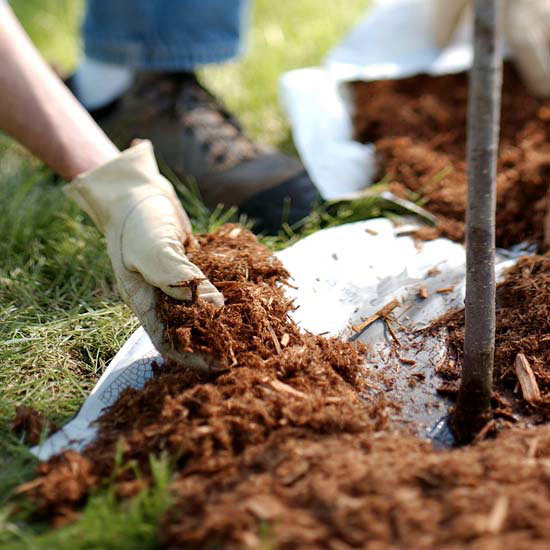






Mulch does a host of things that your plants want and need: shading roots on hot days, preventing moisture from evaporating, stopping weeds from taking root. But it's important to learn the differences between mulch materials, and how to properly spread mulch.
The first question: Do you garden? There are two basic kinds of mulch: Organic and inorganic. Organic materials -- wood, bark, compost, grass clippings, and leaves -- will decompose and improve the soil as they do. They last a few years, after which you'll need to add more. In addition, organic mulches are easy to spread, and do no harm if mixed into soil, as will happen when planting annuals or shrubs, for example. Stone, by contrast, is meant to be a more or less permanent mulch, to be put in place atop a layer of landscape fabric, and then left alone. It's the lowest-maintenance option but not easy to work plant in. So the key question to ask yourself is: Will I be doing any gardening that requires digging and moving mulch aside to plant ornamentals? If the answer is yes, you will want to stick with an organic mulch.
Pick the right mulch for your garden. Every kind of organic mulch has pros and cons. For example, bark nuggets are widely available but can float away in heavy rain. Cocoa hulls have a distinct aroma (some like it, some don't) but are relatively expensive, and toxic to dogs. Shredded bark or wood is the most common landscape mulch—it's inexpensive and easy to apply, but doesn't add as many nutrients to soil as some other mulches.
You can also use waste from your yard as mulch, such as grass clippings, leaves, and compost. Compost adds a lot of nutrients but isn't good at deterring weeds. If you composted it yourself at home, it's not a good idea to mulch beds with it, unless you know that the compost got hot enough to kill weed seeds. Otherwise, you might end up with more weeds, not less! Grass clippings are effective as mulch, but don't pile them too deeply or they can get soggy and mucky. And be sure never to use clippings as mulch if the grass was treated with herbicides. Leaves are an excellent mulch if they're shredded first. Pine needles are long lasting and an excellent mulch where around acid-loving plants like azaleas, because pine needles acidify soil.
Find the best mulch for your landscape.
Calculate how much mulch to buy. There's nothing more frustrating than choosing the mulch you want and not having enough.
Use our handy mulch calculator to figure out how much mulch you need.
Not too thick, not too thin. Spread mulch about 2 to 3 inches thick. Anything thicker could harbor pests, but at the very least is wasteful and unnecessary.
There's no perfect time to apply mulch to beds. Your plants will welcome mulch anytime of the year. If you apply mulch in late fall or early winter and you live in a cold climate, wait until the ground freezes before mulching.
Mulch trees and shrubs properly. Mulching around trees and shrubs is a great way to prevent injury from mowers and trimmers. As with beds, spread mulch 2–3 inches thick. Do not pile mulch against the trunk like a volcano -- this can encourage pests and diseases.
Copyright © www.100flowers.win Botanic Garden All Rights Reserved